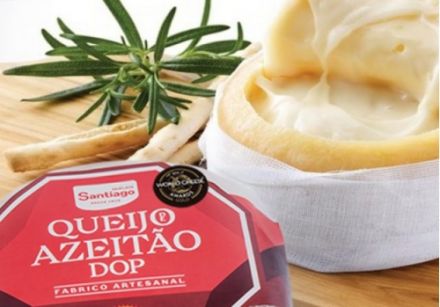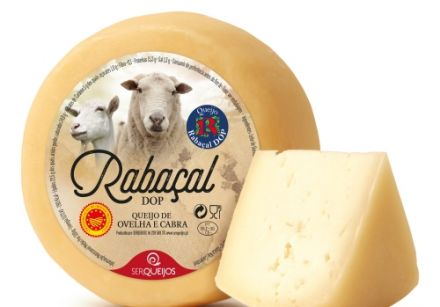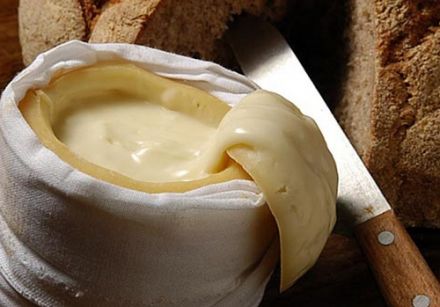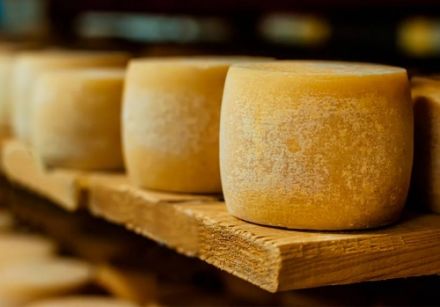 |
All about portuguese cheeses
With the kind assistance of Jorge Tavares da Silva
Unlike the cheese platters of France, Italy, Belgium and England, the Portuguese cheese platter is not, unfortunately, very diverse.
However, there exist cheeses of very high quality, particularly sheep's and goat's milk cheeses, produced mostly in the Iberian plateau of Portugal, the region situated more or less between the Mondego river in the north, the Sado in the south, and the Guadiana to the east, produced from milk coming from the high plateaus and alpine pastures of Estrela in east-central Portugal.
Inevitably, and because (thankfully) their production is still very artisanal, production decreases during the summer and fall months.
There is also a type of specific cheese produced in the Azores from cow's milk, a legacy of the Flemish settlers who first settled the archipelago and began raising cattle in the pastures that reminded them of their far-off native land.
In Portugal, there is also a habit that must be firmly denounced - that of serving "non-cheese"! Let me explain...
From north to south in Portugal, in every restaurant (with a few rare exceptions), there is a shameful, yet prevalent, tradition when it comes to cheese. Inevitably they serve "Queijo flamengo," a sort of fake Edam, with no flavor or character, the production of which was introduced into Portugal in the 1930s north of Aveiro, where the good pasture land is conducive to cattle raising.
This "Queijo flamengo" is, along with "Queijo em triângulos" (processed cheese in individual triangular portions), the best example I can give of "non-cheese," too often served in Portugal to end a meal.
Demand real cheese!

Undoubtedly the biggest group, sheep's milk cheeses are produced mainly in the mountainous massif of "Serra da Estrela", with an elevation of 2000 meters, about 200-250 km northeast of Lisbon.
> Azeitao
A small town south of the Tage, about 40 km east of Lisbon, it produces a runny soft cheese weighing 300 g, cylindrical, about 15 cm, named after the town.
The rind is pale yellow and smooth and the curd creamy, with tiny holes. It is slightly strong in flavor.
In Alcacer do Sal (south of Azeitao) and in Vila Franca-de-Xira (in the northwest), cheeses of the same type are produced, generally named for their place of origin.
> Castelo Branco
The capital of the province de Beira Baixa, the town of Castelo Branco, situated about 270 km northeast of Lisbon, is a production center for various cheeses. They produce a sheep's milk cheese called " à ovelheira", a soft cheese weighing about 1 kg, of the "serra" variety (see below), but which has its own characteristics: salty, tangy and suave in flavor.
> Evora
From the name of the capital of the province of Alto Alentejo, about 150 km east of Lisbon, these small (100-150 g) hard cheeses are fairly strong and salty and split into strips under a knife. Also known as "queijinhos do Alentejo" (little cheeses from Alentejo), they are sometimes preserved in olive oil and are then less hard.
> Saloio
Go below to fresh cheese
> Santarém
A small (150 g) cylindrical cheese eaten after a fairly long soak in olive oil. Its name comes from its town of origin, the capital of Ribatejo province, a center of Portuguese gastronomy about 180 km northeast of Lisbon, on the north bank of the Tage.
> Serpa
In this little town of the Baixo Alentejo, about 200 km southeast of Lisbon, they produce a brick-colored cheese. The color comes from the fact that, as the cheese ages, the rind is regularly brushed with olive oil tinted with sweet paprika.
This cheese is produced only from February to June and requires two years aging in cheese cellars.
The curd of the serpa, dotted with little holes, is firm and strongly-flavored, making it one of the most surprising Portuguese cheeses.
> Serra
Produced in the "Serra da Estrela" region, exclusively from sheep's milk curdled by infusing cardoon flowers in it, or better yet, the stomach acid of suckling lambs. This is a soft cylindrical cheese with slightly bulging sides, weighing 1-2 kg, 25 cm in diameter and 5-7 cm high. The rind is straw colored.
It is available in two stages of ripeness, that correspond to two kinds of texture:
> Amanteigado
Literally "like butter," that is, smooth, runny and unctuous, often tied with a cloth to hold the curd in. Delicate flavor and aroma. Its production is limited to a few months of the fall and winter.
- Curado
Literally "ripened," with a hard rind and crumbly curd and more aassertive flavor and aroma.
In certain coastal regions, they also produce cheeses of this type that aren't permitted to be called "Serra," but that are very pleasant.

Most farmers and shepherds make cheese for their own consumption that are seldom found on the market. You'll come across some very good ones depending on your travels and the season, but there are only two whose designations cover a definite type.
> Cabreiro de castelo branco
White and soft when fresh, it becomes progressively stronger and slightly grayer after a week of ripening.
The curd of this cheese, which is produced only in the fall, tends to harden and become saltier as it ages.
> Rabaçal
Produced in the province of Beira Litoral 200 km north of Lisbon, Rabaçal is a cheese weighing about 1 kg, with a white curd, most often served when fresh.
You'll find Rabaçal cheeses made from sheep's milk or a mixture of milk, but they're only derivatives - though sometimes honorable ones - of the real thing.

The best known is undoubtedly Saloio, described above, but there are fresh cheeses found in every region, made from sheep's, goat's or cow's milk, or a mixture.
Often presented at table in their molds (cinchos), these are excellent cheeses that are perfect for preparing the palate for the dishes to come, or that clear the palate when tasted between two ripened cheeses. There is also another dairy product that can be classified with fresh cheeses:
> Saloio
A small unsalted firm fresh cheese, always served in the cylindrical molds (cinchos) used in making it, about 5 cm in diameter and 6 cm high. This cheese is often served as an appetizer with a little salt.
In some restaurants in and around Lisbon, it is usual to offer these cheeses as an hors d'oeuvre. They're produced in the region between Lisbon and Sintra.
In the old days, farm wives from around the capital would go door to door two or three times a week to sell their products which they transported in attractive rattan baskets with two flap lids.
> Requeijao
Requeijao is produced from whey, the residue of cheese production. About 10% whole milk is added to the whey and the mixture is heated (hence the Italian name ricotta, meaning recooked), and skimmed.
The skimmed thin cream is placed into round wicker baskets and drained.
This produces the requeijao, literally "re-cheese", low in fat and enjoyable with salt (or sugar), accompanied by some good bread.
The best known requeijao is from Serra da Estrela, followed by that from the Saloios region near Lisbon.

> Sao Jorge
Apart from certain so-called Flamengo cheeses, a kind of fake Edam mentioned in the introduction, the only true Portuguese cheese made exclusively from cow's milk is Sao Jorge, the name of another island in the Azores, where it originated.
Also known as "Queijo da ilha" (island cheese), Sào Jorge is the largest of Portuguese cheeses. It weighs up to 7 kg, with a crumbly straw-colored hard curd, with a flavor both mild and bitter, becoming stronger as it ages. Sào Jorge is certainly the most tangible legacy in gastronomic terms of the first Flemish colonists who settled in the archipelago at the request of Henry the Navigator in the 15th century.

Sheep/goat, sheep/cow or sheep/goat/cow, in proportions that vary by region and season, mixed milk cheeses are found throughout Portugal. The two best known which are entitled to their own designations are Pico and Tomar.
> Pico
Named after one of the nine islands of the Azores archipelago, this was originally a cow's milk cheese, but it is now often mixed with goat's milk. A cylindrical cheese weighing about 350 g, with a yellow rind and soft curd, and a strong flavor, its powerful aroma varies according to the degree of aging.
> Tomar
From the name of a small town 150 km northeast of Lisbon, known for its gastronomic specialties and well-known to tourists for its famous Manueline-style window in the Templar convent.
Tomar is the smallest of Portuguese cheeses. It weighs barely 20-50 g, can be eaten fresh or aged, and is semi-soft. In Portugal it is known as "Queijinho de Tomar".

-

 Recipes
Recipes
-

 Products
Products
-

 Entertaining
Entertaining
-

 Chefs
Chefs
-

 Hints & Tips
Hints & Tips
-

 Glossaries
Glossaries








